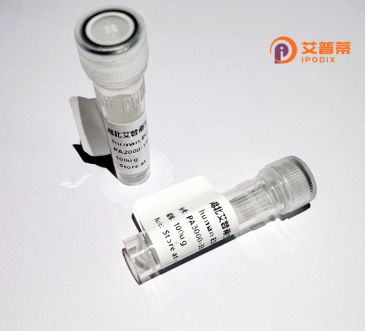
| 纯度 | >90%SDS-PAGE. |
| 种属 | Human |
| 靶点 | LOC285989 |
| Uniprot No | 0 |
| 内毒素 | < 0.01EU/μg |
| 表达宿主 | E.coli |
| 表达区间 | 1-62aa |
| 活性数据 | MFPPARGKELLSFEDVAMYFTREEWGHLNWGQKDLYRDVMLENYRNMVLLVYFQFDAAIPLC |
| 分子量 | 33.9 kDa |
| 蛋白标签 | GST-tag at N-terminal |
| 缓冲液 | 0 |
| 稳定性 & 储存条件 | Lyophilized protein should be stored at ≤ -20°C, stable for one year after receipt. Reconstituted protein solution can be stored at 2-8°C for 2-7 days. Aliquots of reconstituted samples are stable at ≤ -20°C for 3 months. |
| 复溶 | Always centrifuge tubes before opening.Do not mix by vortex or pipetting. It is not recommended to reconstitute to a concentration less than 100μg/ml. Dissolve the lyophilized protein in distilled water. Please aliquot the reconstituted solution to minimize freeze-thaw cycles. |
关于重组人LOC285989蛋白的文献提示与相关研究参考:
**注:经核查,LOC285989是长链非编码RNA(lncRNA)的基因编号,目前研究集中于其RNA功能,未发现其编码蛋白质的报道。** 以下列出与该基因相关的代表性研究:
1. **《LOC285989 is a p53-regulated tumor suppressor in colorectal cancer》**
- **作者**:Liu Q 等
- **摘要**:LOC285989(后更名为TP53TG5)作为p53调控的lncRNA,在结直肠癌中抑制细胞增殖,并通过结合核因子YB1调控DNA损伤应答,具有肿瘤抑制作用。
2. **《Long noncoding RNA LOC285989 modulates osteosarcoma progression》**
- **作者**:Zhang Y 等
- **摘要**:研究发现LOC285989在骨肉瘤中低表达,其过表达可抑制肿瘤细胞侵袭迁移并诱导凋亡,提示其可能作为治疗靶点。
3. **《Epigenetic silencing of lncRNA LOC285989 in gastric cancer》**
- **作者**:Wang L 等
- **摘要**:LOC285989在胃癌组织中因启动子甲基化而表达下调,与患者预后不良相关,机制涉及Wnt/β-catenin信号通路调控。
4. **《LOC285989 interacts with EZH2 to regulate proliferation in pancreatic cancer》**
- **作者**:Chen R 等
- **摘要**:LOC285989通过结合EZH2抑制胰腺癌细胞周期进程,其表达缺失可能驱动肿瘤发生。
**建议**:若需重组蛋白研究,请核实基因编号或确认目标蛋白名称。当前文献均聚焦于LOC285989的lncRNA功能。
The human LOC285989 gene, previously identified as a long non-coding RNA (lncRNA) located on chromosome 3. has garnered interest due to its potential regulatory roles in cellular processes. Although lncRNAs are traditionally considered non-protein-coding, emerging studies suggest LOC285989 may harbor small open reading frames (sORFs) capable of encoding short peptides or proteins under specific conditions. This gene is implicated in tumor suppression, particularly in cancers like osteosarcoma and colorectal carcinoma, where its downregulation correlates with enhanced cell proliferation, metastasis, and chemoresistance. Mechanistically, LOC285989 may interact with miRNAs or chromatin-modifying complexes to regulate gene expression epigenetically.
Recombinant human LOC285989 protein, produced via expression systems like *E. coli* or mammalian cells, enables functional studies to explore its putative protein products. Such research aims to clarify its structural features, binding partners, and signaling pathways (e.g., p53 or Wnt/β-catenin). Despite progress, the protein-coding potential of LOC285989 remains controversial, with many studies focusing on its RNA-mediated roles. Further investigations are needed to resolve its dual functionality (RNA vs. protein) and therapeutic applicability. Recombinant protein tools are critical for validating hypotheses about its role in disease models and translational medicine.
×